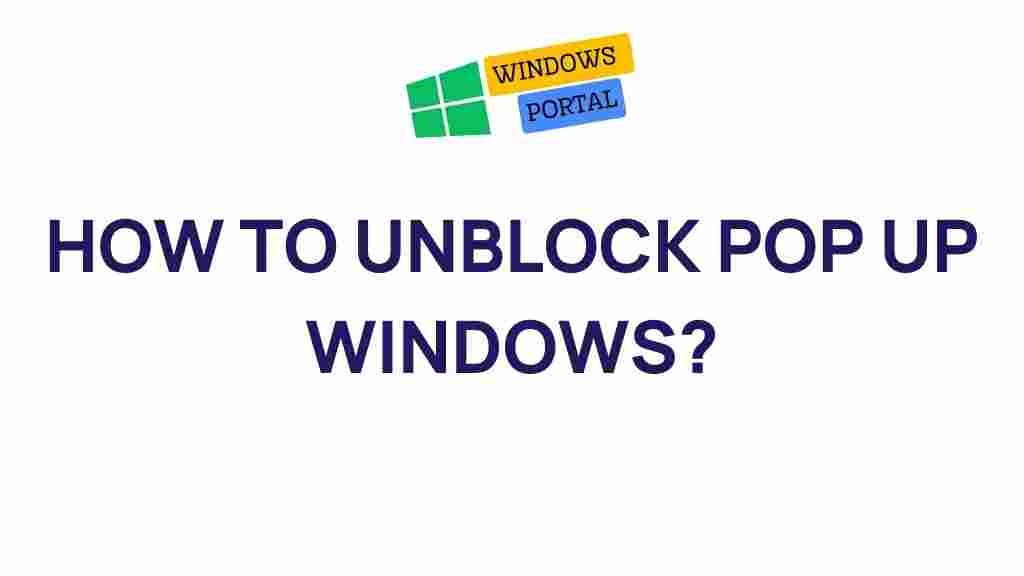Unlock the Secrets to Eliminating Annoying Pop-Up Windows
In today’s digital world, encountering pop-up windows can be incredibly frustrating. These unsolicited interruptions often disrupt our browsing experience and can sometimes lead to malware or unwanted advertising. Fortunately, there are effective strategies to eliminate these pesky nuisances. In this article, we will explore the secrets to eliminating pop-up windows, providing you with step-by-step processes, troubleshooting tips, and more.
Understanding Pop-Up Windows
Before diving into solutions, it’s essential to understand what pop-up windows are. Generally, they are web pages that open in a new browser window, often without the user’s consent. They can serve various purposes:
- Advertisements: Many sites use them to promote products or services.
- Subscription prompts: Websites may ask users to subscribe to newsletters.
- Notifications: Some sites may use them to alert users about important information.
While some pop-up windows are benign, others can be malicious. Understanding their nature is the first step toward controlling them.
Step-by-Step Process to Eliminate Pop-Up Windows
Here are effective methods to reduce or completely eliminate pop-up windows on your browser:
1. Adjust Browser Settings
Most modern web browsers offer built-in options to block pop-up windows. Follow these steps to adjust your settings:
- Google Chrome:
- Open Chrome and click on the three dots in the upper right corner.
- Select Settings.
- Scroll down to Privacy and Security and click on Site Settings.
- Under Content, find Pop-ups and redirects.
- Toggle the setting to Blocked.
- Mozilla Firefox:
- Open Firefox and click on the three horizontal lines in the upper right corner.
- Select Options.
- Click on Privacy & Security.
- Scroll down to the Permissions section and check the box next to Block pop-up windows.
- Safari:
- Open Safari and go to Preferences.
- Click on the Websites tab.
- Select Pop-up Windows from the left sidebar and choose Block and Notify.
2. Install Pop-Up Blocker Extensions
If your browser’s built-in features are not enough, consider installing a pop-up blocker extension. Some popular options include:
- AdBlock Plus: This extension blocks not only pop-up windows but also unwanted ads.
- Poper Blocker: Specifically designed to block all types of pop-up windows.
- uBlock Origin: A lightweight option that offers a robust way to block ads and pop-up windows.
To install an extension, simply visit your browser’s extension store, search for the desired blocker, and follow the installation prompts.
3. Clear Browser Cache and Cookies
Sometimes, pop-up windows can be triggered by corrupted cache files or cookies. Clearing these can help eliminate persistent issues:
- Go to your browser settings.
- Look for Privacy and Security options.
- Select Clear Browsing Data.
- Check the boxes for Cookies and other site data and Cached images and files.
- Click Clear Data.
4. Keep Your Browser Updated
An outdated browser can be more susceptible to pop-up windows and other vulnerabilities. Regular updates often include security patches that can help combat this issue. To update your browser:
- Open your browser and go to the menu.
- Select Help or About.
- Your browser will check for updates and install them if available.
Troubleshooting Tips for Persistent Pop-Up Windows
If you continue to experience issues with pop-up windows, consider the following troubleshooting tips:
1. Disable JavaScript Temporarily
Some pop-up windows are triggered by JavaScript. Disabling it temporarily can help identify the source:
- Go to your browser’s settings.
- Navigate to Site Settings.
- Select JavaScript and toggle it off.
After testing, remember to turn JavaScript back on, as many websites require it to function properly.
2. Scan for Malware
Malware can often cause unwanted pop-up windows. Use trusted antivirus software to perform a full system scan. Some reputable options include:
- Malwarebytes: A popular choice for removing various types of malware.
- Avast: Offers comprehensive scanning and real-time protection.
- Bitdefender: Known for its robust malware protection features.
3. Check Installed Extensions
Some browser extensions can be the culprit behind annoying pop-up windows. Review your installed extensions and disable any that look suspicious or that you don’t recognize:
- Go to your browser’s extension settings.
- Review the list and remove or disable unnecessary extensions.
Conclusion
In conclusion, dealing with pop-up windows can be frustrating, but understanding how to eliminate them can significantly enhance your browsing experience. By adjusting your browser settings, installing blockers, clearing your cache, and performing regular maintenance, you can minimize interruptions and improve your online security. If issues persist, consider the troubleshooting tips mentioned above.
For further reading on enhancing your online experience, visit this informative resource. If you’re looking for more tips on browsing safely, check out our other articles here.
This article is in the category Guides & Tutorials and created by GalaxyTips Team
